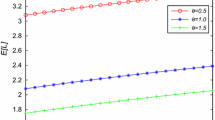Abstract
We consider an M / G / 1 queue in which the customers, while waiting in line, may renege from it. We show the Nash equilibrium profile among customers and show that it is defined by two sequences of thresholds. For each customer, the decision is based on the observed past (which determines from what sequence the threshold is taken) and the observed queue length (which determines the appropriate element in the chosen sequence). We construct a set of equations that has the Nash equilibrium as its solution and discuss the relationships between the properties of the service time distribution and the properties of the Nash equilibrium, such as uniqueness and finiteness.
Similar content being viewed by others
Notes
Upon arrival, everyone is a type ii customer, who potentially may switch to type i due to being present in the queue while service completion occurred.
We note that although we provided in this paper the probability density of \(f_A|N=n\) for \(n=1\) and \(n=2\) only, by following the same line of thought it can be obtained for every \(n\le n_\mathrm{max}-1\), only with a much greater complexity. Even for \(n=3\) (that is \(n_\mathrm{max}=4\)), it gets extremely difficult.
The vector \((\alpha _1,\ldots ,\alpha _n)\) represents the locations of the customers’ classes in the queue
References
Afeche, P., Pavlin, M.: Rational abandonment from priority queues: equilibrium strategy and pricing implications. Manag. Sci. (2015) (Under review)
Baccelli, F., Boyer, F., Hebuterne, G.: Single server queues with impatient customers. Adv. Appl. Probab. 16, 887–905 (1984)
Baccelli, F., Hebuterne, G.: On queues with impatient customers. In: Performance, pp. 159–179 (1981)
Balow, R.E., Proschan, F.: Statistical theory reliability and life testing: Probability models. Hold, Rinehart and Winston, New York (1975)
Barrer, D.Y.: Queuing with impatient customers and ordered service. Oper. Res. 5, 650–656 (1957)
Cripps, M., Thomas, C.: Strategic Experimentation in Queues (2014) www.ed.ac.uk/files/imports/fileManager/queues2402131.pdf
Boxma, O., Perry, D., Stadje, W., Zacks, S.: The busy period of an M/G/1 queue with customer impatience. J. Appl. Probab 45(1), 130–145 (2010)
Brandt, A., Brandt, M.: Workload and busy period for the M/GI/1 with a general impatience mechanism. Queueing Syst. 75, 189–209 (2013)
Debo, L., Hassin, R., Veeraraghavan, U. S.: Learning quality through service outcomes (2012)
Hassin, R., Haviv, M.: To Queue or Not to Queue: Equilibrium Behavior in Queueing Systems. Kluwer Academic Publishers, Boston (2003)
Hassin, R.: Rational Queueing. Chapman & Hall, London (2016)
Hassin, R., Haviv, M.: Equilibrium strategies for queues with impatient customers. Oper. Res. Lett 17, 41–45 (1995)
Haviv, M., Ritov, Y.: Homogeneous customers renege from invisible queues at random times under deteriorating waiting conditions. Queueing Syst. 38, 495–508 (2001)
Mandelbaum, A., Shimkin, N.: A model for rational abandonments from invisible queues. Queueing Syst. 36, 141–173 (2000)
Mandelbaum, A., Shimkin, N.: Rational abandonment from tele-queues: nonlinear waiting costs with heterogeneous preferences. Queueing Syst. 47, 117–146 (2004)
Naor, P.: The regulation of queue size by levying tolls. Econometrica 37(1), 15–24 (1969)
Palm, C.: Methods of judging the annoyance caused by congestion. Tele 2, 1–20 (1953)
Acknowledgements
Thanks are due to Prof. Refael Hassin for making helpful comments. This research is supported by the Israel Science Foundation, Grant No. 1319/11.
Author information
Authors and Affiliations
Corresponding author
Appendix A
Appendix A
Proof
We give explicit expressions for both the numerator and the denominator.
The numerator is
and the denominator is
After taking the derivative, we obtain the p.d.f. of \(Q|Q \le R(0,a)\wedge A_2\wedge (I(T_1-a)+(1-I)(A_1-W_1))\), and hence of \(Y|N=2,A=a\) as well. \(\square \)
Rights and permissions
About this article
Cite this article
Sherzer, E., Kerner, Y. Customers’ abandonment strategy in an M / G / 1 queue. Queueing Syst 90, 65–87 (2018). https://doi.org/10.1007/s11134-017-9567-5
Received:
Revised:
Published:
Issue Date:
DOI: https://doi.org/10.1007/s11134-017-9567-5




